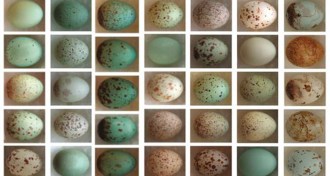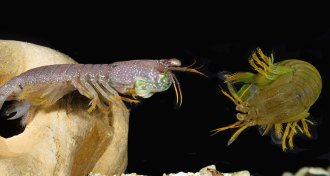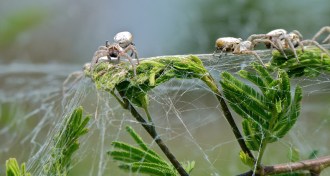All Stories
-
 Genetics
GeneticsEbola continues to shift, but grows no more fatal
In the West African epidemic, Ebola evolved and spread quickly, but the virus is not becoming deadlier over time.
-
 Science & Society
Science & SocietyDeflategate favored foul play over science
Science didn’t get center stage in the rulings on whether the New England Patriots underinflated footballs during championship game against the Indianapolis Colts.
-
 Earth
EarthDinosaurs may not have seen the Grand Canyon after all
New geologic comparisons peg the Grand Canyon’s inception well after dinosaurs went extinct.
-
 Animals
AnimalsUnpredictable egg scramble throws off parasitic parents
Eggs of some species of warbler and weaver birds appear to have individual signatures, which can help distinguish them from the eggs of parasitic cuckoos.
-
 Animals
AnimalsHow mantis shrimps spar
In ritualized combat between deadly mantis shrimp, blows count but don’t kill.
By Susan Milius -
 Science & Society
Science & SocietyHome-brewed heroin: Hold the hype
Now is the time to think about policy for synthetically produced morphine, but the process, if it bears out, is years away from working.
-
 Astronomy
AstronomyMars-sized exoplanet is smallest to have its mass measured
The smallest exoplanet to be weighed is a hot, rocky cousin of the Red Planet.
-
 Animals
AnimalsOne bold, misinformed spider slows a colony’s ability to learn
Incorrect ideas prove more dangerous in bold velvet spiders than in shyer ones.
By Susan Milius -
 Earth
EarthMost of Earth’s impact craters await discovery
Hundreds of undiscovered impact craters probably dot Earth’s surface, new research estimates.
-
 Health & Medicine
Health & MedicineAntibiotics can treat appendicitis
Antibiotics can successfully treat the majority of cases of a type of appendicitis, researchers find.
By Meghan Rosen -
 Astronomy
AstronomyPluto at last
Precision matters, whether looking at global temperatures, subatomic particles or the carefully timed approach to a faraway world.
By Eva Emerson -
 Planetary Science
Planetary ScienceWater’s origin story, science and sci-fi and more reader feedback
Readers discuss how Earth got its water, chat about a hot spot's violent past and more.